Lifestyle
Bernice Johnson Reagon, a founder of The Freedom Singers and Sweet Honey in the Rock, has died

Bernice Johnson Reagon, seen here at the memorial celebration for Odetta at Riverside Church in 2009 in New York City.
Astrid Stawiarz/Getty Images
hide caption
toggle caption
Astrid Stawiarz/Getty Images

Bernice Johnson Reagon, seen here at the memorial celebration for Odetta at Riverside Church in 2009 in New York City.
Astrid Stawiarz/Getty Images
Bernice Johnson Reagon, a civil rights activist who co-founded The Freedom Singers and later started the African-American a cappella ensemble Sweet Honey in the Rock, has died at the age of 81.
Reagon’s death was confirmed Wednesday night by Courtland Cox, the chairman of the Student Nonviolent Coordinating Committee’s Legacy Project.
It is impossible to separate liberation struggles from song. And in the 1960s — at marches, and in jailhouses — the voice leading those songs was often Bernice Johnson Reagon. Her work as a scholar and activist continued throughout her life, in universities and concert halls, at protests and in houses of worship.
The future songleader was born in southwest Georgia, the daughter of a Baptist minister. She was admitted to a historically Black public college, Albany State, at the age of 16 and studied music. Albany, Ga., would become an important center of the civil rights movement when Dr. Martin Luther King Jr. was arrested there in 1962, causing the media to descend on the town.
Dr Bernice Johnson Reagon Will The Circle Be Unbroken
YouTube
Reagon, however, wasn’t there to see it. “I was already in jail, so I missed most of that,” she wryly remembered on WHYY’s Fresh Air in 1988. “But what they began to write about… no matter what the article said, they talked about singing.”
The singing that so fascinated the media were freedom songs — often revamped versions of spirituals familiar to anyone who’d grown up in African-American churches. Reagon would later say that in many cases, she simply replaced the word “Jesus” with “freedom,” as in the rousing “Woke Up This Morning.”
After Albany State kicked her out due to her arrest, the rising civil rights organizer co-founded The Freedom Singers, an a cappella group that was part of the SNCC. Through music, the Freedom Singers chronicled SNCC’s activities, including a movement leader’s funeral (“They Laid Medgar Evers In His Grave”) and a visit from a Kenyan dignitary brought in by the State Department to demonstrate America’s strides towards racial integration (“Oginga Odinga”).
Such intertwining of songs and resistance helped define the era and those who fought for equality, says civil rights professor Kevin Gaines.
“When they were being arrested and loaded into the paddywagons, when they were in jail, when they were having mass meetings in African-American churches to organize the next protest, civil rights activists sang in all of those settings,” says Gaines.
Reagon remembered, on Fresh Air, that being the good kind of troublemaker was not necessarily encouraged.
“If you grow up in a black family, the best badge you can have is that you never got into trouble with the law,” she said. But she drew a parallel between the struggle for civil rights and biblical stories like those of Paul and Silas, who were jailed for their ministry.
“When you’re in the civil rights movement, that’s the first time you establish yourself in a relationship that’s pretty close to the same relationship that used to get the Christians thrown in the lion’s den,” she said. “And so, for the first time, those old songs you understand in a way that nobody could ever teach you.”
In 1963, Bernice Johnson married Freedom Singers co-founder Cordell Reagon. They had two children, Kwan Tauna and Toshi, who would go on to become a musical star in her own right. After her 1967 divorce, Reagon returned to school, received a Ford Foundation Fellowship, and founded the women’s a cappella group Sweet Honey in the Rock.
Sweet Honey in the Rock Performs “Stranger” at NPR
YouTube

Her activism grew to encompass the anti-apartheid movement. She became a leading scholar of Black musical life. In 1974, she received a music history appointment at the Smithsonian; in 1989 she won a “genius grant” from the MacArthur Foundation. In 1994, she created a 26 part NPR documentary called Wade in the Water that won a Peabody award. And in 1995, she was awarded the Presidential Medal and the Charles E. Frankel Prize.
Wade in the Water was a listener’s guide to African American sacred music — one that celebrated the ways in which both worship and liberation are sacred.

Lifestyle
Joe Jonas Says New Album Was Personal Therapy Nearly Year After Divorce
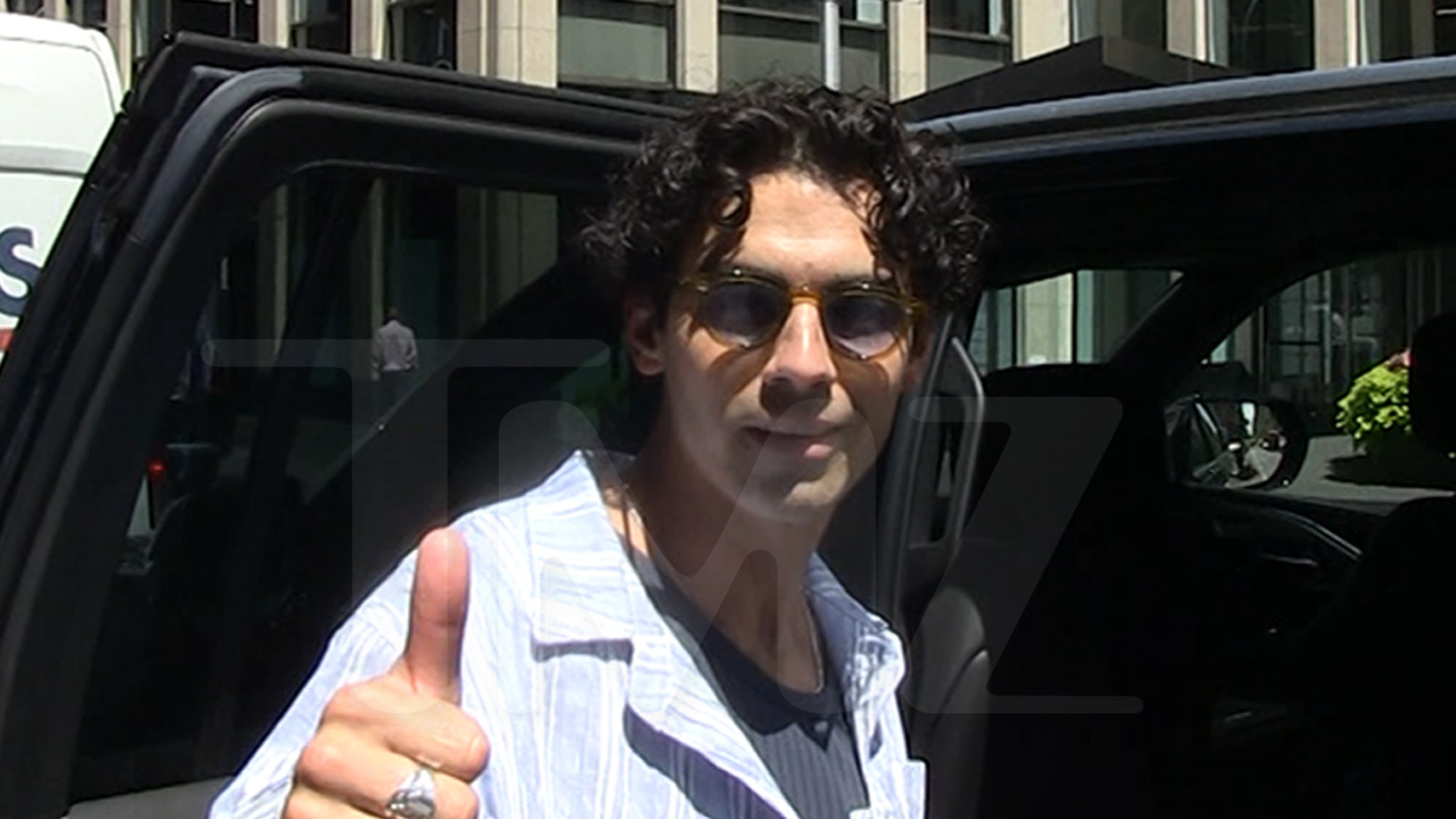
TMZ.com
Joe Jonas says his new album served as his own form of therapy nearly a year after he filed to divorce Sophie Turner — and he’s promising some great tunes as a result.
We caught the singer in New York City Wednesday — where our photog asked him about this project of his that’s coming out soon … the first solo album he’s put out in a while, titled “Music for People Who Believe in Love.”
Waiting for your permission to load the Instagram Media.
Joe’s been hyping this thing up as incredibly personal — which makes sense in light of what he’s been going through since he and his wife split up. So, when we asked if he’d been getting on the couch in the lead-up to this … he had an interesting answer.
Check it out … Joe says the making of the album was therapy in and of itself — and it sounds like he’s cosigning therapy in general, telling us it’s fantastic.
Waiting for your permission to load the Instagram Media.
Of course, Joe’s been open about going to therapy before — while he was still married to Sophie, that is — but him talking about it now carries new significance … especially considering how acrimonious his split with ST has been at times.
We’ve seen the ex-Disney Channel star and the ‘GoT’ actress battle it out in court over custody of their 2 daughters, Willa and Delphine.

While Sophie has moved on with British aristocrat Peregrine Pearson, Joe had a short-lived romance with actress Stormi Bree … although, he has since cozied up to Lebanese actress Laila Abdallah.
In any case … here’s hoping all the turmoil got channeled into good music — Joe’s saying we’re all in for a treat!
Lifestyle
Here are the 2024 Emmy nominations

76th EMMY® AWARDS NOMINATIONS ANNOUNCEMENT
YouTube
The Television Academy announced nominations for the 2024 Primetime Emmy Awards on Wednesday. Shogun leads nominations with 25 on the drama side, while The Bear brought in a comedy category record of 23.
Winners will be announced at the 76th Primetime Emmy Awards on September 15.
Outstanding comedy series
Abbott Elementary
The Bear
Curb Your Enthusiasm
Hacks
Only Murders in the Building
Palm Royale
Reservation Dogs
What We Do in the Shadows
Outstanding supporting actor in a comedy series

Lionel Boyce, The Bear
Paul W. Downs, Hacks
Ebon Moss-Bachrach, The Bear
Paul Rudd, Only Murders in the Building
Tyler James Williams, Abbott Elementary
Bowen Yang, Saturday Night Live
Outstanding supporting actress in a comedy series

Carol Burnett, Palm Royale
Sheryl Lee Ralph, Abbott Elementary
Hannah Einbinder, Hacks
Janelle James, Abbott Elementary
Liza Colon-Zayas, The Bear
Meryl Streep, Only Murders in the Building
Outstanding lead actress in a comedy series

Quinta Brunson, Abbott Elementary
Ayo Edebiri, The Bear
Selena Gomez, Only Murders in the Building
Maya Rudolph, Loot
Jean Smart, Hacks
Kristen Wiig, Palm Royale
Outstanding lead actor in a comedy series

Matt Berry, What We Do in the Shadows
Larry David, Curb Your Enthusiasm
Martin Short, Only Murders in the Building
Steve Martin, Only Murders in the Building
Jeremy Allen White, The Bear
D’Pharaoh Woon-A-Tai, Reservation Dogs
Outstanding drama series

The Crown
Fallout
The Gilded Age
The Morning Show
Mr. and Mrs. Smith
Shogun
Slow Horses
3 Body Problem
Outstanding lead actor in a drama series

Idris Elba, Hijack
Donald Glover, Mr. and Mrs. Smith
Walton Goggins, Fallout
Gary Oldman, Slow Horses
Hiroyuki Sanada, Shogun
Dominic West, The Crown
Outstanding lead actress in a drama series

Jennifer Aniston, The Morning Show
Maya Erskine, Mr. and Mrs. Smith
Carrie Coon, The Gilded Age
Anna Sawai, Shogun
Imelda Staunton, The Crown
Reese Witherspoon, The Morning Show
Outstanding supporting actor in a drama series

Billy Crudup, The Morning Show
Tadanobu Asano, Shogun
Mark Duplass, The Morning Show
Jon Hamm, The Morning Show
Takehiro Hira, Shogun
Jack Lowden, Slow Horses
Jonathan Pryce, The Crown
Outstanding supporting actress in a drama series

Christine Baranski, The Gilded Age
Nicole Beharie, The Morning Show
Elizabeth Debicki, The Crown
Greta Lee, The Morning Show
Lesley Manville, The Crown
Karen Pittman, The Morning Show
Holland Taylor, The Morning Show
Outstanding limited or anthology series

Baby Reindeer
Fargo
Lessons in Chemistry
Ripley
True Detective: Night Country
Outstanding lead actress in a limited or anthology series or movie

Jodie Foster, True Detective: Night Country
Brie Larson, Lessons in Chemistry
Juno Temple, Fargo
Sofia Vergara, Griselda
Naomi Watts, Feud: Capote vs. the Swans
Outstanding lead actor in a limited or anthology series or movie

Matt Bomer, Fellow Travelers
Richard Gadd, Baby Reindeer
Jon Hamm, Fargo
Tom Hollander, Feud: Capote vs. the Swans
Andrew Scott, Ripley
Outstanding supporting actress in a limited or anthology series or movie

Dakota Fanning, Ripley
Lily Gladstone, Under the Bridge
Jessica Gunning, Baby Reindeer
Aja Naomi King, Lessons in Chemistry
Diane Lane, Feud: Capote vs. The Swans
Nava Mau, Baby Reindeer
Kali Reis, True Detective: Night Country
Outstanding supporting actor in a limited or anthology series or movie

Jonathan Bailey, Fellow Travelers
Robert Downey Jr., The Sympathizer
Tom Goodman-Hill, Baby Reindeer
John Hawkes, True Detective: Night Country
Lamorne Morris, Fargo
Lewis Pullman, Lessons in Chemistry
Treat Williams, Feud: Capote vs. The Swans
Outstanding reality competition program

The Amazing Race
RuPaul’s Drag Race
Top Chef
The Traitors
The Voice
Outstanding talk series

The Daily Show
Jimmy Kimmel Live
Late Night with Seth Meyers
The Late Show with Stephen Colbert
You can see the full list of nominees here.
Amazon supports NPR and pays to distribute some of our content.
Lifestyle
In a hot L.A. neighborhood full of brown lawns, his DIY native plant garden thrives
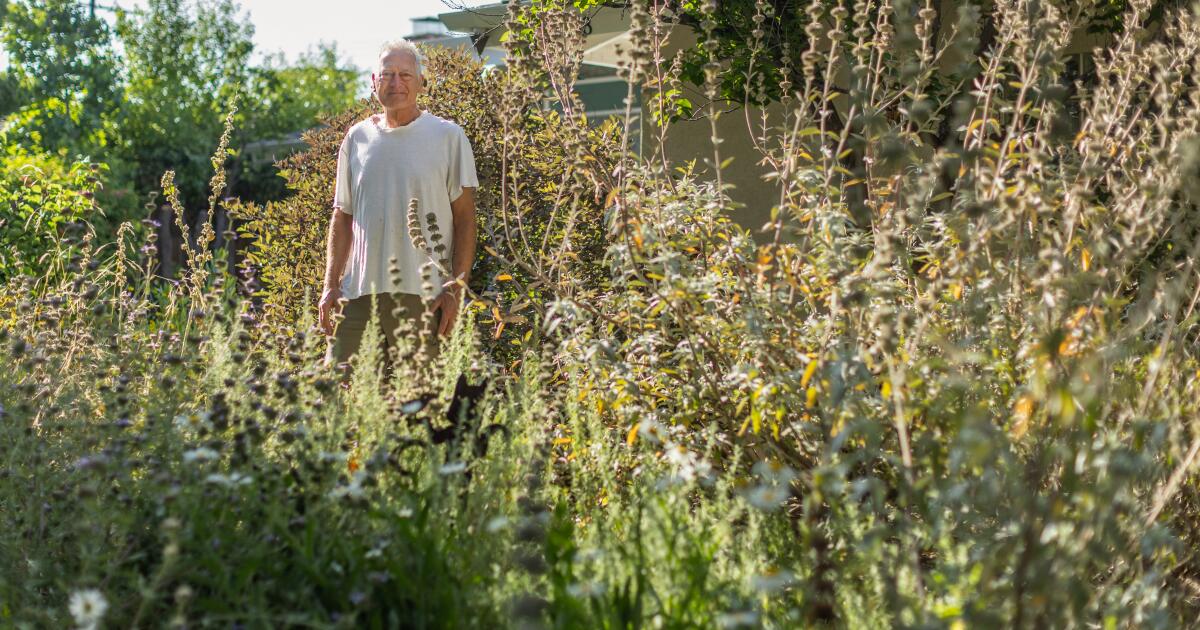
Water-hungry lawns are symbols of Los Angeles’ past. In this series, we spotlight yards with alternative, low-water landscaping built for the future.
The temperature was in the 90s in West Hills, but that didn’t deter an astonishing number of monarch butterflies, hummingbirds and bees from feeding on the California-friendly plants — sages, salvias and flowering milkweed — in Eric Augusztiny’s front yard.
Pollinators, however, aren’t the only ones who call the front yard home. “This is our buddy, Lizzy,” Augusztiny said with a smile as he and his wife, Lise Ransdell, greeted an enormous lizard who crawled out from under a large salvia ‘Desperado’ plant.
“It’s just a postage stamp suburban yard, but there’s a lot going on here,” Ransdell said of the yard’s abundant wildlife, which counts rabbits, skunks, raccoons and possums as visitors.
It wasn’t always like this. When Augusztiny purchased the home in 1996, the traditional yard looked like many others on his street with a Bermuda grass lawn, assorted shrubs and an apricot tree.
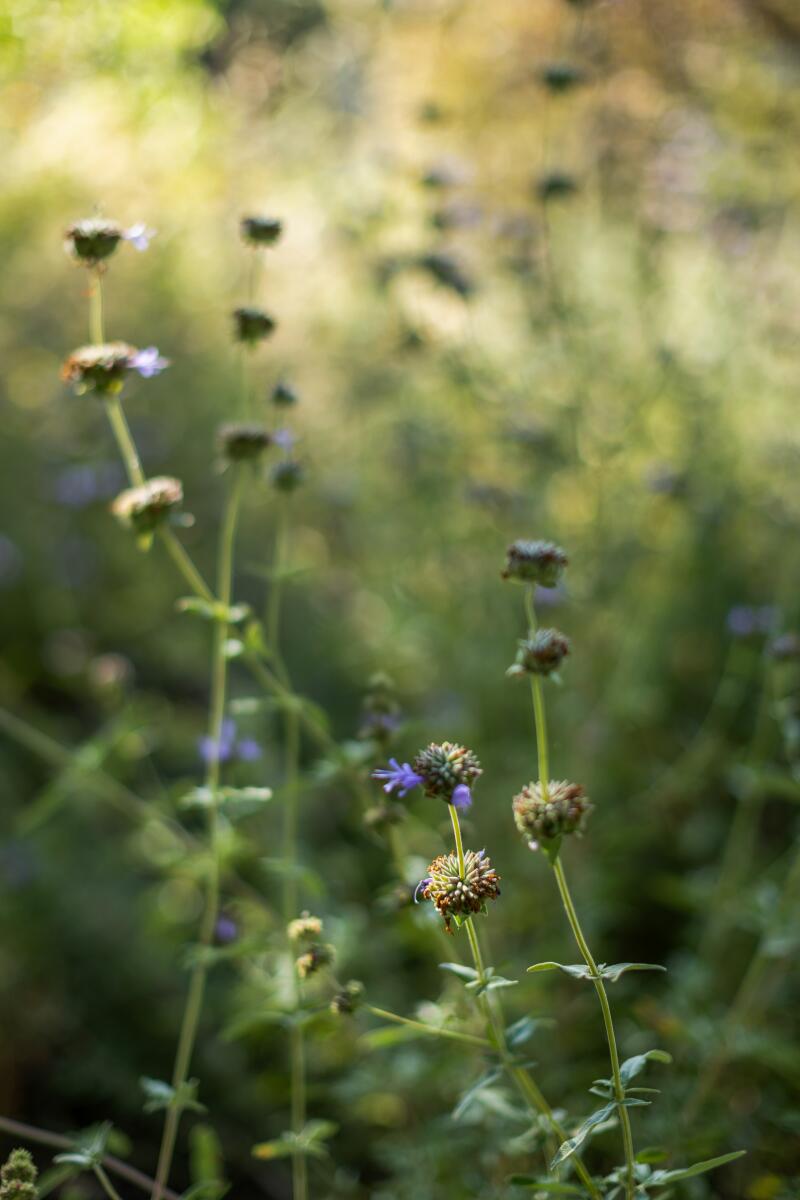
Milkweed, a favorite of monarch butterflies, left. Cleveland sage, Salvia clevelandii. (Myung J. Chun / Los Angeles Times)
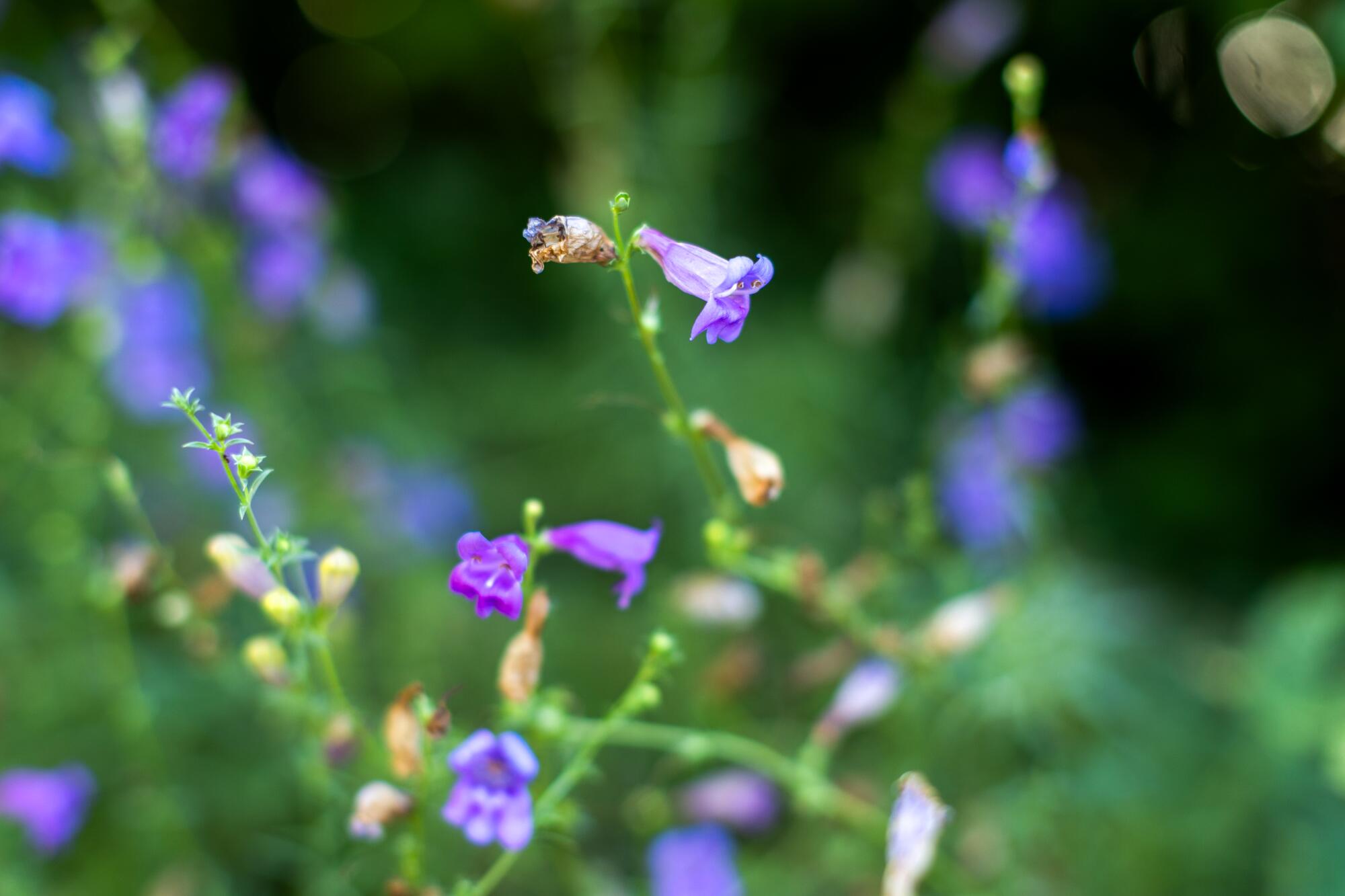
Foothill penstemon grows in Eric Augusztiny’s drought-tolerant front yard.
Yes, Augusztiny acknowledges, lawns have appeal, but not in his West Valley neighborhood where “concrete is the equivalent of a frying pan,” and sustaining thirsty turf in triple-digit heat is impossible. “Even if I wanted a lawn — and I don’t — you can’t keep one alive here,” he said, pointing to the brown lawns that border his tree-lined street.
“The garden goes dormant in the summer but doesn’t die. Drought-tolerant plants are survivors. The sugar bush, toyon, manzanita, coffee berry, ceanothus and hummingbird sage hold their vivid green color year-round. The California fuchsia blooms into the fall, and although the salvias’ spikes above the foliage die back after flowering, the structure and leaves remain vital.”
Besides mowing the lawn, Augusztiny was not much of a gardener before he purchased his home. “I knew how to reseed the lawn. Again and again,” he said with a laugh. So he decided to learn all he could about removing his lawn, building healthy soil and replacing it with a drought-tolerant alternative.
He started by attending a demonstration on lasagna mulching led by artist-in-residence and horticulturist Leigh Adams at the Los Angeles County Arboretum’s Crescent Farm. The class inspired Augusztiny, who then checked out books on California native plants from the Los Angeles Public Library and attended a hands-on workshop at the Metropolitan Water District of Southern California Field Office.
When the couple remodeled their home in 2018, they decided it was a good time to remove the lawn. The LADWP’s lawn conversion program — which currently pays $5 per square foot to remove turf and replace it with low-water landscapes — was an incentive but not the primary driving force. “I wasn’t in it for the money,” Augusztiny said of the $2,000 rebate they received then, “but it helped cover the cost.”
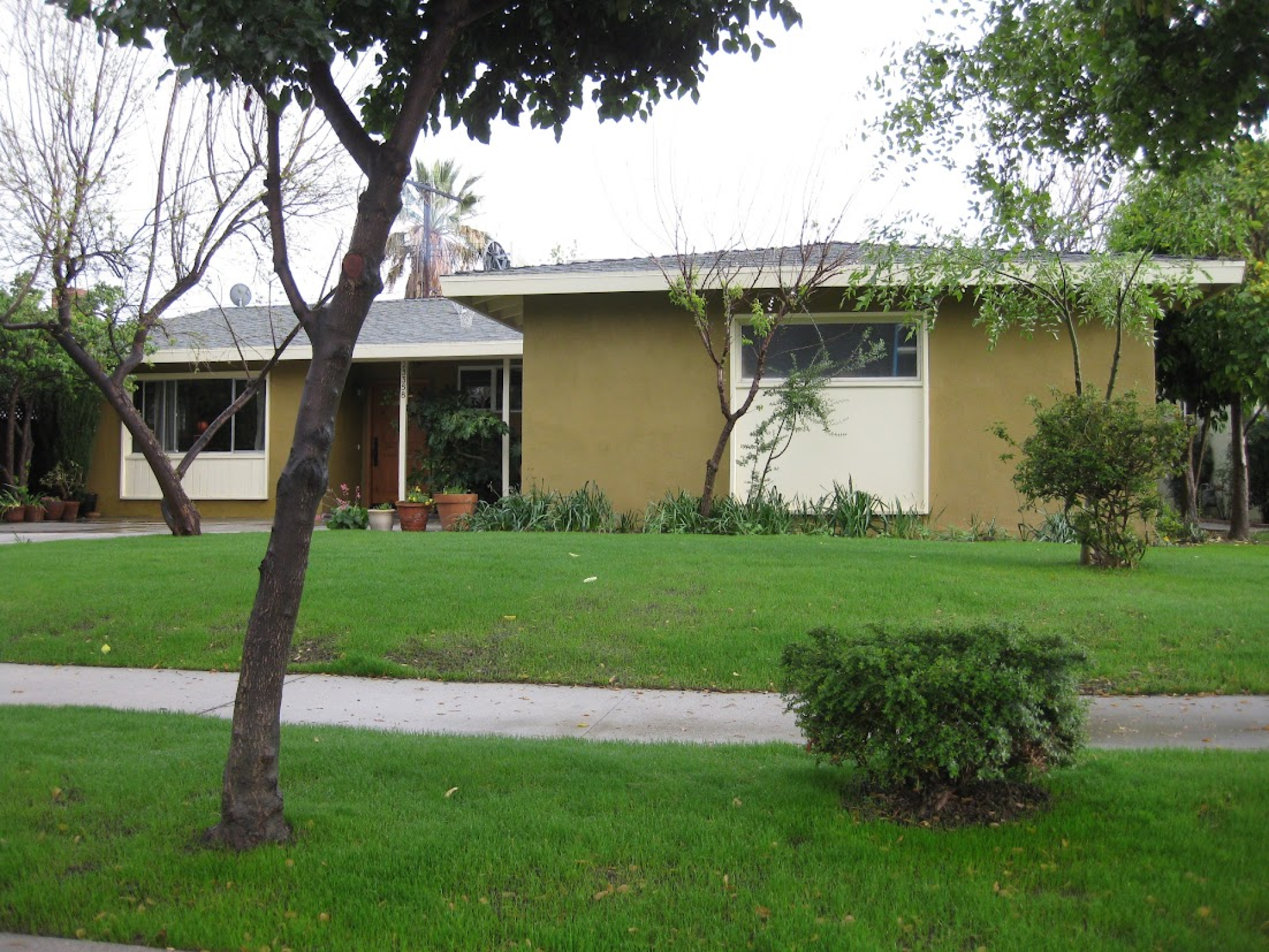
Eric Augusztiny’s front yard in West Hills before he removed his lawn and replaced it with a drought-tolerant alternative.
(Eric Augusztiny)
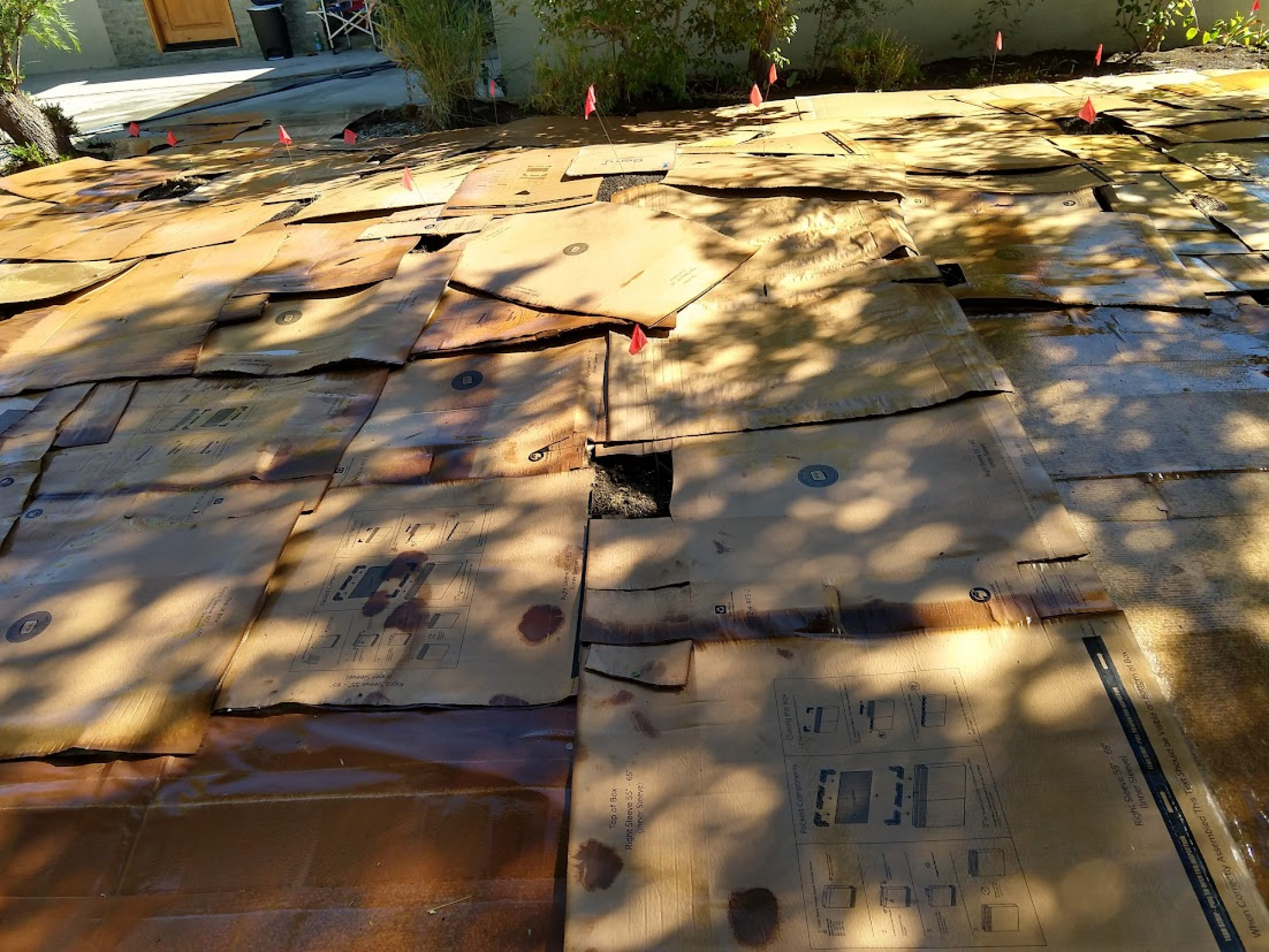
Eric Augusztiny’s front lawn is smothered in cardboard during the sheet mulching process.
(Eric Augusztiny)
Suitably educated, Augusztiny decided to tear out his lawn and plant a low-water substitute himself. Just don’t call him a designer. “It was a process of figuring out a simple design, getting the drip system in and putting down the cardboard,” Augusztiny said of the process known as sheet mulching, where the cardboard is wetted down and covered with 3 inches of mulch.
When he smothered his lawn with cardboard, his neighbors often asked him what he was doing. “I told them I was getting rid of the Bermuda grass,” he recalled. “They all told me, ‘Good luck with that.’”
Taking classes offered Augusztiny some revelations as he planned his garden. He followed Adams’s suggestion to “paint with wildflowers” and scattered wildflower seeds on top of established plants. He planted hummingbird sage after he read that it grows well in the shade of oak trees. Concerned about the depletion of Western monarch butterflies due to habitat loss, he felt it was important to plant Narrow-leaf milkweed (Asclepias fascicularis). “They have since shown up in droves,” he said.
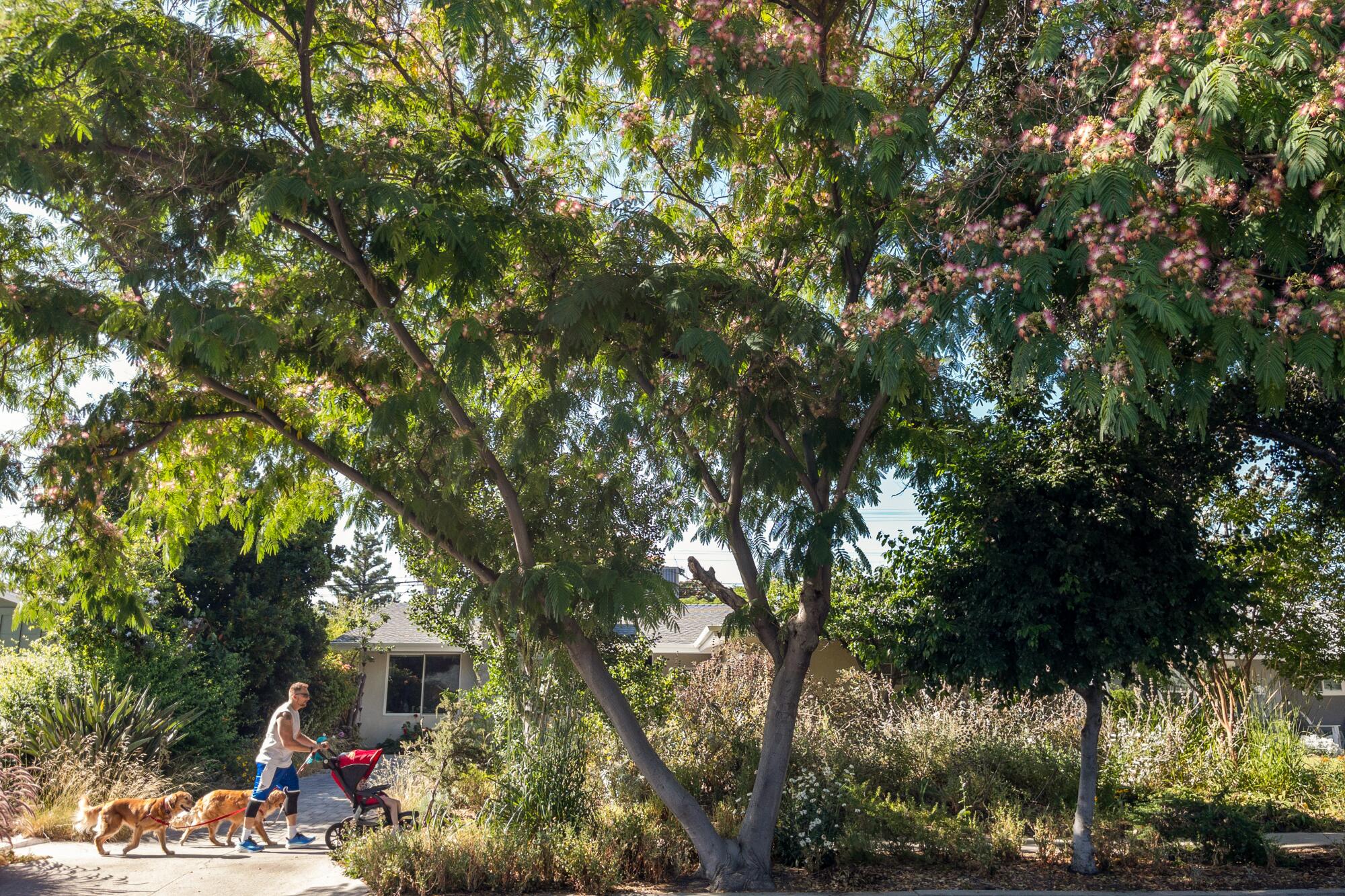
On the parkway, a coast live oak, Catalina cherry and silk tree provide shade. Augusztiny collects water using a rain barrel and rain chains. He also installed drip irrigation.
Regarding plants, Augusztiny made treks to native plant nurseries all over Los Angeles, including the California Botanic Garden in Claremont, Theodore Payne Foundation in Sunland and Pierce College in Woodland Hills. “Now, I have to stop because I’m generating my plants from harvesting the seeds and taking cuttings,” he said. “You can generate and regenerate the garden.” He even picked up free animal waste from the Los Angeles Zoo (known as “zoo doo”) at the Griffith Park Composting Facility.
He admits he killed some native plants initially because he overwatered them in the summer. That ended when he took a three-month hands-on course in native garden maintenance with Antonio Sanchez of the Santa Monica Mountains Fund in 2022. “I learned that drought-tolerant plants strengthen during the rainy season to ride out the dry season,” he said. He stopped drowning plants in the summer because he thought they were thirsty.
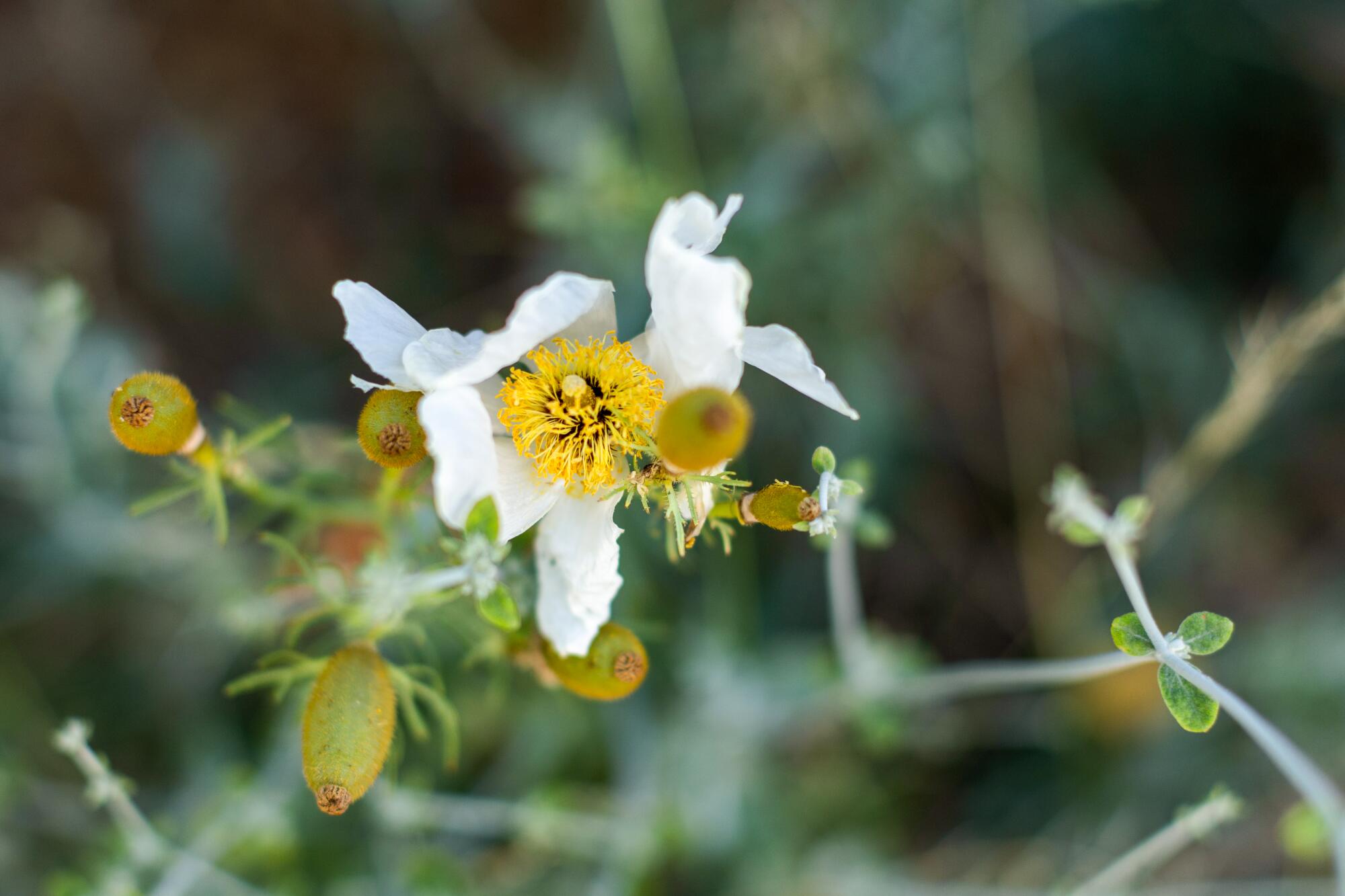
A Matilija poppy grows in Eric Augusztiny’s drought-tolerant front yard.
After six years, Augusztiny thinks Adams’ “sleep, creep, leap” mantra has finally materialized. “She told us the plantings would sleep the first year, creep the second and then leap in the third,” he explained. “Ah, but with only 11.5 inches from 2020-2022, the garden wasn’t moving.”
Fast-forward two years. After two years of record rainfall in Los Angeles, the California native habitat has overwhelmed the front yard.
“I hate to steal a title from a Hollywood film,” said the actor, “but suddenly it was everything, everywhere all at once.”
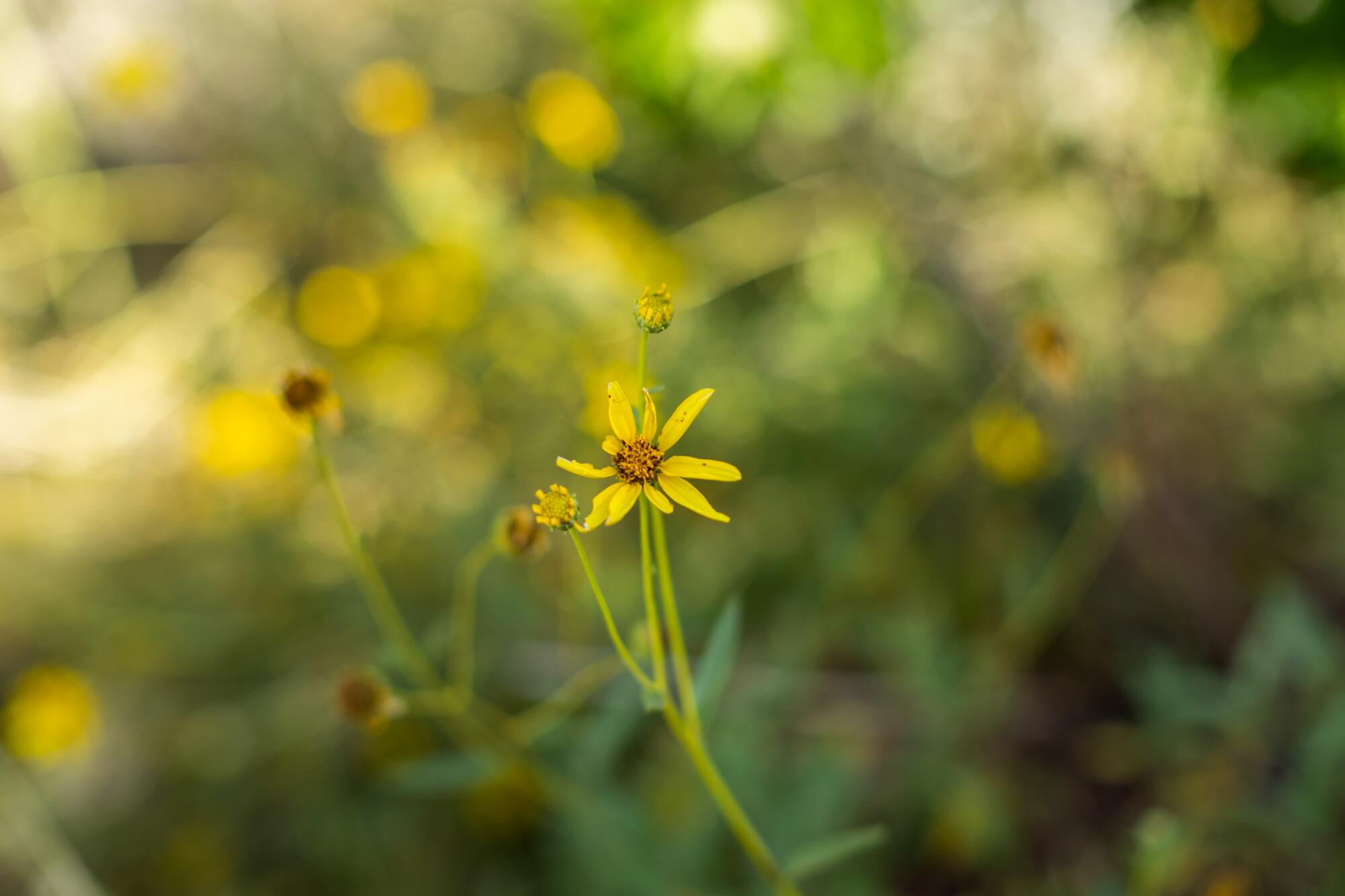
Narrowleaf sunflower grows in the garden.
The garden is wild and colorful with a heavenly fragrance attributed to the exploding sages — Cleveland (Salvia clevelandii), hummingbird (Salvia spathacea) and white (Salvia apiana) — along with colorful wildflowers like the fire-resistant California fuchsia (Epilobium canum) and purple Foothill penstemon (Penstemon heterophyllus).
Although many of the larger drought-tolerant plants are planted away from the street, some, such as bigberry manzanita (Arctostaphylos glauca), are dwarfed by California buckeye (Aesculus californica), coffeeberry (Frangula californica) and sugar bush (Rhus ovata).

Rain chains capture rainwater from the roof.

Augusztiny’s front yard and parking strip are overflowing with drought-tolerant plants.
No longer a gardening novice, the Seattle native passionately advocates the “need to do our small part to help stem climate change.” He thinks creating a native habitat in his front yard and installing rain barrels and a permeable driveway in the face of record-breaking heat waves is a good place to start.
“I enjoy nature, and Los Angeles has it all,” he said. “I’m not a purist when it comes to plants. I like to refer to them as climate-appropriate. But the more blacktops we can eliminate and the less stormwater runoff there is, the better our water quality and lives will be.”
Now, when neighbors walk their kids to school, they don’t ask him what he’s doing in his front yard. “They compliment the garden,” said Augusztiny, who waters twice a month. “The garden is not just for me. It’s for everyone.”
Plants in this garden
Arabian lilac (Vitex trifolia)
Coffee berry (Frangula californica)
Sugar bush (Rhus ovata)
Cleveland sage (Salvia clevelandii)
Narrow leaf milkweed (Asclepias fascicularis)
Black sage (Salvia mellafera)
White sage (Salvia apiana)
Purple sage (Salvia leucophylla)
Bigberry manzanita (Arctostaphylos glauca)
Palmer’s abutilon (Abutilon palmeri)
Desperado sage (Salvia desperado)
Penstemon heterophyllus ‘Margarita BOP’
California fuchsia (Epilobium canum)
Purple needle grass (Nassella pulchra)
Australian emu bush (Eremophila glabra)
Snow berry (Symphoricarpos mollis)
California buckwheat (Eriogonum fasciculatum)
Hummingbird sage (Salvia spathacea ‘Las Pilitas’)
Nuttall’s sunflower (Helianthus nuttallii)
Giant wildrye (Elymus condensatus)
Toyon ( Heteromeles arbutifolia )
Dudleya abramsii
Coulter’s Matilija poppy (Romneya coulteri)
Ceanothus griseus var. horizontalis ‘Yankee Point’
Fiesta Marigold monkeyflower (Mimulus ‘Fiesta Marigold)
Mimulus (Diplacus) ‘Fiesta Marigold’
-

 World1 week ago
World1 week agoAfter Moscow, Hungary's Orbán makes surprise visit to Beijing
-

 World1 week ago
World1 week agoAustralia appoints special envoy to combat anti-Semitism
-

 Movie Reviews1 week ago
Movie Reviews1 week agoFilm Review: The Bikeriders – Soundsphere magazine
-

 California1 week ago
California1 week agoTwo arrested in connection to separate California wildfires
-

 News1 week ago
News1 week agoBiden tells Hill Democrats he is staying in the race | CNN Politics
-

 World1 week ago
World1 week agoIndia’s Modi makes first Russia visit since Ukraine invasion
-

 News1 week ago
News1 week agoHow to fight shrinkflation? Pay attention to unit prices at grocery stores
-

 Movie Reviews1 week ago
Movie Reviews1 week agoFilm Review: Pierce (2024) by Nelicia Low















